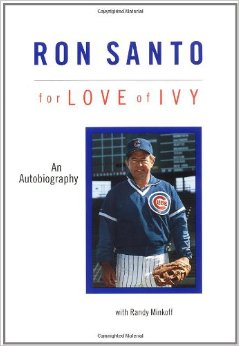
From the baseball journal Nine.
Ron Santo: For Love of Ivy
By Ron Santo with Randy Minkoff. Bonus Books Inc., 160 E. Illinois St., Chicago, IL 60611, 1993, 213 pp., hardcover.
Reviewed by: William S. Bike
Ron Santo is the last unreconstructed 1969 Chicago Cub. While other members of the team have made their peace with the Mets, the third-baseman/author still can’t stand them and still asserts that the New Yorkers in no way were the best team.
In other words, he’s just like a typical Cub fan.
That’s what will most endear readers to Ron Santo: For Love of Ivy. Santo is the last hero of ’69 to write his autobiography, and it was perhaps necessary for him to take so long. For it has required nearly a quarter-century for some Cub fans to come to grips with their feelings concerning the star who was never quite as beloved as the eternally boyish Ernie Banks, the quietly competent Billy Williams, or the overachieving Jim Hickman.
Perhaps it is because the fans’ frustrations had to be directed at someone that Santo, who describes himself in the book as “an emotional Italian,” was a convenient target. One would have felt one was committing sacrilege in booing Ernie or Billy; Santo, with his heel-clicking and anti-Don Young diatribe, left himself open and vulnerable. Both are examined in the book, with the Young incident getting an entire chapter. Some “fans” went so far as to send hate mail and death threats; these also are fully discussed.
For Cub fans of that era, this book will provide a reconciliation. On page after page, Santo reveals that he’s one of them: he believes the ’69 Mets were arrogant jerks, he misses the days when players didn’t have a fence around their cars to keep the fans away, he thinks baseball was better when teams stayed together for years on the field and played together off of it, and he is proud of the fact that the ‘60s Cubs needed the fans and often knew the rooters by their first names.
It wasn’t until Ron Santo Day in 1971, after Santo had been in the Major Leagues for 11 years, that he revealed to the world his diabetes. His career ended three years later, so his daily struggle against the disease was never before fully detailed. The accounts make for some of the book’s most fascinating reading: how he felt that as a 20-year-old athlete he could live without insulin—until he saw an equally healthy looking diabetic fall off of a chair and go into a coma; how he played basketball to the point of exhaustion after his diagnosis to learn how much and when insulin was needed; and his inspiring work with the Juvenile Diabetes Foundation.
While much has been written about the Cubs’ Greek Tragedy of ’69, little has been written about the Cubs of the early and middle ‘60s, when there were more people in the College of Coaches than in the seats of Wrigley Field. Santo fills in the blanks about this era, revealing the frustrations of playing for a different manager every few weeks, reminding readers of greatness cut short by the tragic death of Cub Rookie of the Year second-baseman Ken Hubbs, and providing clear understanding as to how a young adult could be so awed with being in the bigs that he wouldn’t even care that he played for one of the league’s doormat teams.
Chapters are devoted to Leo Durocher, Don Young, 1969, Santo’s switch to the White Sox in 1974 (including a revelation of tampering by Sox manager Chuck Tanner), entry into the business world, and a comparison of ‘60s players to today’s. You can guess who comes out on top, and by the way pal, that ’84 Cub club, like the Mets, can’t hold a candle to the Santo-led heroes of ’69, according to the Hall of Fame-hopeful.
However, the book has a plethora of mistakes, some of which would disturb even casual baseball fans. For the sake of accuracy, the publishers should have indicated that the book was by Santo as told to Randy Minkoff.
One can assume that Santo remembers he wore No. 10, not Ernie’s 14 (blasphemy!) as indicated on page 2. Banks had to retire and Hickman was still a Cub in 1971, despite assertions to the contrary on page 109. Milt Pappas pitched his no-hitter in 1972, not the previous season (p. 121). Readers still are waiting for the missing conclusion of Chapter 12. And worst of all, page 168 says the Mets entered the league in 1968! You mean the Cubs were beat out by a second-year team, Ron?
And unfortunately, there are more. It would have been nice if Santo had actually read a final galley of this book before it went to press, and one could have expected better of Minkoff, a radio sports talk show host and former editor and columnist for UPI.
Still, for those who fondly remember baseball in the 1960s, when players were both gods and approachable; for Cub fans who can’t get enough of the sweet pain of ’69; and for younger fans who know Santo only as a Cub broadcaster, Ron Santo: For Love of Ivy is worth purchasing. Perhaps more fastidious fans may want to wait for the paperback, when the many factual and typographical errors presumably will have been excised.
Leave a Reply